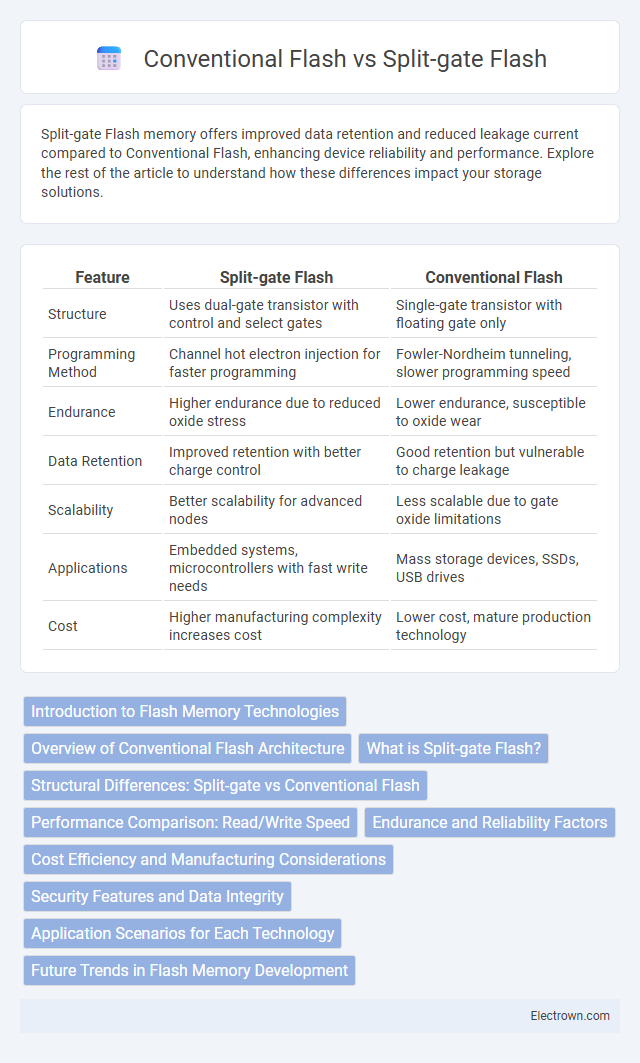Split-gate Flash memory offers improved data retention and reduced leakage current compared to Conventional Flash, enhancing device reliability and performance. Explore the rest of the article to understand how these differences impact your storage solutions.
Table of Comparison
| Feature | Split-gate Flash | Conventional Flash |
|---|---|---|
| Structure | Uses dual-gate transistor with control and select gates | Single-gate transistor with floating gate only |
| Programming Method | Channel hot electron injection for faster programming | Fowler-Nordheim tunneling, slower programming speed |
| Endurance | Higher endurance due to reduced oxide stress | Lower endurance, susceptible to oxide wear |
| Data Retention | Improved retention with better charge control | Good retention but vulnerable to charge leakage |
| Scalability | Better scalability for advanced nodes | Less scalable due to gate oxide limitations |
| Applications | Embedded systems, microcontrollers with fast write needs | Mass storage devices, SSDs, USB drives |
| Cost | Higher manufacturing complexity increases cost | Lower cost, mature production technology |
Introduction to Flash Memory Technologies
Split-gate flash memory incorporates a dual-gate structure that enhances data retention and reduces leakage current compared to conventional single-gate flash memory. This advanced architecture allows for more precise control of electron tunneling, improving endurance and reliability in non-volatile storage applications. Conventional flash memory relies on a singular floating gate, which can lead to higher power consumption and faster degradation over repeated program/erase cycles.
Overview of Conventional Flash Architecture
Conventional Flash memory architecture relies on a floating-gate transistor design, where charge is stored in a polysilicon floating gate insulated by oxide layers. This structure enables data retention by trapping electrons in the floating gate, but it faces challenges such as charge leakage and limited endurance due to program/erase cycles. The floating-gate's susceptibility to interference and scaling limitations impacts cell reliability and density in advanced memory technologies.
What is Split-gate Flash?
Split-gate Flash is a type of NAND flash memory that incorporates an additional gate structure called the "split gate," which separates the control gate from the floating gate, enhancing charge control and reliability. This architecture reduces leakage current and improves endurance compared to conventional flash memory by isolating the tunneling oxide under the control gate. Split-gate Flash is widely used in embedded systems and microcontrollers due to its enhanced data retention and program/erase cycle durability.
Structural Differences: Split-gate vs Conventional Flash
Split-gate Flash memory features an additional gate, called the control gate, positioned adjacent to the floating gate, enhancing charge control and retention compared to conventional Flash memory that relies on a single control gate above the floating gate. This structural difference enables split-gate Flash to reduce electron leakage and improve endurance, making it more reliable for repeated write/erase cycles. Understanding these distinctions helps you choose the right Flash technology based on performance and durability requirements.
Performance Comparison: Read/Write Speed
Split-gate Flash memory offers improved read/write speed compared to Conventional Flash due to its enhanced charge retention and reduced interference between cells. Its architecture allows for faster program and erase cycles, resulting in higher overall memory performance. Conventional Flash typically exhibits slower speeds due to increased cell-to-cell interference and less efficient charge management.
Endurance and Reliability Factors
Split-gate Flash memory enhances endurance and reliability by reducing electron trapping and minimizing oxide degradation compared to Conventional Flash. Its isolated gate structure limits program/erase stress, resulting in higher cycling endurance and improved data retention over time. These factors make Split-gate Flash particularly advantageous for applications requiring extended device lifespan and consistent performance.
Cost Efficiency and Manufacturing Considerations
Split-gate Flash technology offers improved cost efficiency by reducing cell size and enabling higher memory density compared to Conventional Flash, leading to lower cost per bit. Manufacturing Considerations highlight that Split-gate Flash requires more precise fabrication steps and advanced lithography, increasing initial production complexity but optimizing yield through reduced cell interference. Economies of scale in Conventional Flash production still favor lower upfront capital expenditure, while Split-gate Flash investments pay off in long-term cost savings due to enhanced scalability and reliability.
Security Features and Data Integrity
Split-gate Flash memory offers enhanced security features compared to conventional Flash by incorporating additional control gates that reduce susceptibility to charge leakage and unauthorized data access. Its architecture improves data integrity through better isolation of memory cells, minimizing interference and enhancing resistance to data corruption caused by environmental factors. Conventional Flash, while widely used, presents higher risks of data retention loss and vulnerability to hacking techniques due to simpler cell designs and fewer protective mechanisms.
Application Scenarios for Each Technology
Split-gate Flash technology excels in applications requiring high data retention and reliability, such as consumer electronics, automotive systems, and industrial controls, due to its improved charge trapping and reduced leakage. Conventional Flash remains preferred for cost-sensitive, high-density storage solutions like USB drives and SSDs, benefiting from mature manufacturing processes and faster write speeds. The choice between Split-gate and Conventional Flash depends on balancing endurance, performance, and cost to suit specific use cases in embedded systems or mass storage.
Future Trends in Flash Memory Development
Split-gate Flash memory offers enhanced endurance and reduced leakage compared to Conventional Flash, making it a promising candidate for future high-density storage solutions. Emerging trends emphasize scaling Split-gate technology to nanometer dimensions while integrating 3D architectures for increased capacity and performance. Advanced materials like high-k dielectrics and novel charge-trapping layers further drive improvements in reliability and energy efficiency in next-generation Flash memory devices.
Split-gate Flash vs Conventional Flash Infographic

 electrown.com
electrown.com